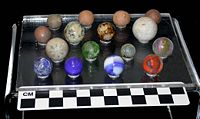Marbles: Difference between revisions
imported>Pat Palmer m (→Marbles games) |
imported>Pat Palmer |
||
| Line 20: | Line 20: | ||
</div> | </div> | ||
== | == Figures of speech == | ||
Linguistic studies have been conducted surrounding the unique terminology that has developed around marble playing, both anciently and in modern times in varied cultures.<ref>Harder, Kelsie B. "The Vocabulary of Marble Playing." Publications of the American Dialect Society, 1955, 23:3-34.</ref> In modern English vernacular, marbles have taken on various figurative meanings. To "lose one's marbles" means to lose one's mind, go insane. To "pick up/take one's marbles and go home" means to leave abruptly as in disgust or in a fit of pique. | Linguistic studies have been conducted surrounding the unique terminology that has developed around marble playing, both anciently and in modern times in varied cultures.<ref>Harder, Kelsie B. "The Vocabulary of Marble Playing." Publications of the American Dialect Society, 1955, 23:3-34.</ref> In modern English vernacular, marbles have taken on various figurative meanings. To "lose one's marbles" means to lose one's mind, go insane. To "pick up/take one's marbles and go home" means to leave abruptly as in disgust or in a fit of pique. | ||
Revision as of 12:00, 24 January 2021
Marbles are small, smooth balls of glass, often tinted or multi-colored. They are useful as toys, ornaments, and collectables. Marbles may vary in size but are typically 1.5cm in diameter or smaller (down to around 1 cm in diameter).
Marbles games
There are various games and varieties of games played using marbles (To play marbles; to shoot marbles). The marble is flicked by the thumb from within the clenched fist of the player. Games usually revolve around strength and accuracy of this flick. A simpler technique, used by less experienced players, is to hold the marble between the thumb and forefinger and shoot it overhand at the target.
In one typical game of marbles, a number of marbles are placed together on the ground in the center of a large circle. The circle may be drawn with chalk or marked in the mud by the point of a stick. The players stand a set distance outside of the circle and take turns to flick their own marble at the group inside the circle. The object is to try to knock the marbles outside of the circle. The player who knocks out the most marbles wins.
Another game using just one marble per player is similar to the game tig-tag crossed with golf. The players must flick their marbles into a specified location, known as the pot. Players take turns to flick their marbles. Once a player has got his or her marble into the pot, they must then try to hit the other players marble with their own. The first player to both enter the pot then hit the opponents marble wins the game.
Games of marbles often include a form of gambling. Typically the winner of the game will get to keep the marbles they knocked out. Successful players will amass a large collection of marbles.
Collectible marbles
Figures of speech
Linguistic studies have been conducted surrounding the unique terminology that has developed around marble playing, both anciently and in modern times in varied cultures.[1] In modern English vernacular, marbles have taken on various figurative meanings. To "lose one's marbles" means to lose one's mind, go insane. To "pick up/take one's marbles and go home" means to leave abruptly as in disgust or in a fit of pique.
- ↑ Harder, Kelsie B. "The Vocabulary of Marble Playing." Publications of the American Dialect Society, 1955, 23:3-34.



